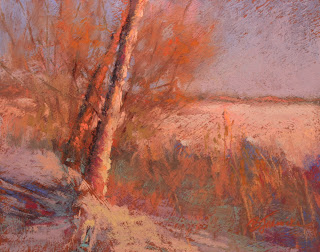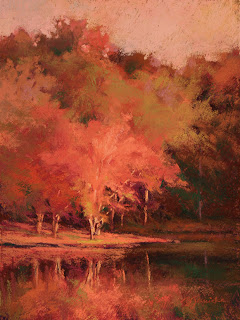 |
| Winter Trees, 8 x 10 |
In my two weekly classes, we recently worked on how to depict those challenging, barren winter trees. I did this quick little study before both classes just as a warm-up for myself and to better explain during my demonstrations how to paint this type of tricky subject matter. I had hoped to post my finished larger piece that I used for both in-class demonstrations. But with a week fraught with fraudulent charges on my debit card, helping my 6 year old do a research paper on walruses, and troubleshooting some annoying computer problems, the larger painting didn't survive the distractions and died a slow death. With a few touch ups to my original study, I decided I liked it better anyway!
Many artists find that their quick studies sometimes look better than work that received their more careful attention. Why? I think one reason is because when we work quickly, we use fewer strokes of each pastel stick. Fewer strokes means fresher, unmuddied color application. Most of us also do a better job of getting down the big shapes quickly without fussing with the details when we know it's just a "practice" piece. For anyone who's taken my class, you know the importance of
big shapes first; details later. This doesn't mean you shouldn't take the time to carefully plan a painting, or that you should always paint very fast. It just means that paintings tend to be more successful when they retain a fresh color application, and that a good artist will know when to skim over the superfluous details and when to slow down and think through the challenging areas.
Just to let you in on a little secret...I actually did an even quicker 5 x 7 study before the 8 x 10 above. So I did already solve a few problems I had with the 5 x 7 before embarking on this one.




